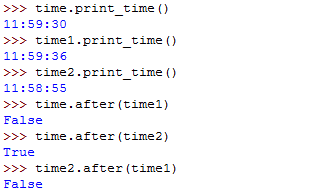As another example of a user-defined type, we’ll define a class called Time that records the time of day. The class definition looks like this:

Write a function print_time that takes a Time object and prints it in the form hour:minute:second.
Write a Boolean function after that takes two Time objects, t1 and t2, and returns true if t1 follows t2 chronologically and False otherwise.
class Time: """ represents the time of day attributes: hour, minute, second""" def print_time(self): print('%d:%d:%d' % (self.hour,self.minute,self.second)) def after(self,t): if(self.hour < t.hour): return False elif(self.hour == t.hour): if(self.minute < t.minute): return False elif(self.minute == t.minute): if(self.second <= t.second): return False else: return True return True time = Time() time.hour = 11 time.minute = 59 time.second = 30 time1 = Time() time1.hour = 11 time1.minute = 59 time1.second = 36 time2 = Time() time2.hour = 11 time2.minute = 58 time2.second = 55

from Thinking in Python